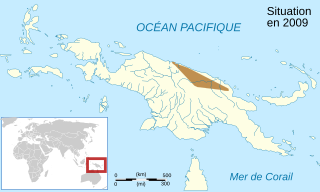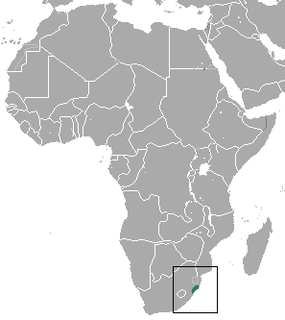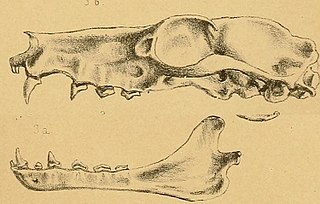Copiula is a genus of microhylid frogs endemic to New Guinea. The common name Mehely frogs has been coined for them. They are leaf-litter inhabitants.

Copiula derongo is a species of frog in the family Microhylidae. It is endemic to New Guinea and found in both Indonesia and Papua New Guinea. The specific name derongo refers to its type locality, the village of Derongo in the Western Province. Based on molecular evidence, it was transferred from Austrochaperina to Copiula in 2016.

Copiula guttata is a species of frog in the family Microhylidae. It is endemic to Papua New Guinea and known from around the head of the Gulf of Papua in the Gulf and Chimbu Provinces. The specific name is the Latin adjective guttata that means "spotted" and refers to the dorsal colour pattern of this species. Based on molecular evidence, it was transferred from Austrochaperina to Copiula in 2016.

Copiula rivularis is a species of frog in the family Microhylidae. It is endemic to Papua New Guinea and known from near the Indonesian border east to the Morobe Province; it is expected to occur in the Papua province of Indonesia. The specific name comes from the Latin adjective pertaining to small brooks or streams and refers to the habitat of this species. Based on molecular evidence, it was transferred from Austrochaperina to Copiula in 2016.
Copiula fistulans is a species of frog in the family Microhylidae. It is endemic to Papua New Guinea and occurs in the northeastern part of New Guinea in Morobe and Northern Provinces. Common name Lae Mehely frog has been coined for this species.
Copiula major is a species of frog in the family Microhylidae. It is found in West Papua, Indonesia and possibly Papua New Guinea. Its natural habitat is subtropical or tropical moist lowland forests. It is threatened by habitat loss.
Copiula minor is a species of frog in the family Microhylidae. It is endemic to Papua New Guinea. Its natural habitats are subtropical or tropical moist lowland forests and subtropical or tropical moist montane forests. It is threatened by habitat loss.
Copiula obsti is a species of frog in the family Microhylidae. It is endemic to the Wondiwoi Mountains in West Papua, Indonesian New Guinea. It is known mature forest at elevations of 400–800 m (1,300–2,600 ft) above sea level. It lives under leaf litter on the forest floor. It is potentially threatened by habitat loss caused by logging.
Copiula oxyrhina is a species of frog in the family Microhylidae. It is endemic to Papua New Guinea. Its natural habitats are subtropical or tropical moist lowland forests, subtropical or tropical moist montane forests, subtropical or tropical seasonally wet or flooded lowland grassland, rural gardens, urban areas, and heavily degraded former forest.
Copiula pipiens is a species of frog in the family Microhylidae. It is known from its type locality, Wirui near Wewak in the north coast of New Guinea, Papua New Guinea, and from the island of Yapen, off the north-western coast of New Guinea, in the West Papua province of Indonesia. The Yapen population might represent a different but closely related species. Common name Wirui Mehely frog has been coined for this species.

Copiula tyleri is a species of frog in the family Microhylidae. It is endemic to northeastern New Guinea and is found in both Western New Guinea and Papua New Guinea. The specific name tyleri honours Michael J. Tyler, Australian herpetologist who have worked extensively with Australian and New Guinean frogs.
Copiula alpestris is a species of frog in the family Microhylidae. It is endemic to Papua New Guinea and known from the Western Highlands, Chimbu, and Eastern Highlands Provinces at elevations of 1,800–2,800 m (5,900–9,200 ft) above sea level. The specific name is a Latin adjective meaning "living in high mountains", in reference to its relatively high-altitude habitats. Based on molecular evidence, the species was transferred from Oxydactyla to Copiula in 2016.
Pseudoeurycea exspectata is a species of salamander in the family Plethodontidae. It is endemic to Guatemala.

The Buettikofer's shrew is a species of mammal in the family Soricidae. It is found in Ivory Coast, Ghana, Guinea, Liberia, Nigeria, and Sierra Leone. Its natural habitat is subtropical or tropical moist lowland forests. It is threatened by habitat loss.

The gracile naked-tailed shrew is a species of mammal in the family Soricidae. It is found in Burundi, Gabon, Kenya, and Uganda. Its natural habitat is swamps.

The Ugandan lowland shrew is a species of mammal in the family Soricidae. It is found in Kenya and Uganda. Its natural habitats are subtropical or tropical swamps and subtropical or tropical moist montane forest. It is threatened by habitat loss.

Babault's mouse shrew is a species of mammal in the family Soricidae found in Burundi, the Democratic Republic of the Congo, and Uganda. Its natural habitat is subtropical or tropical moist montane forests. It is threatened by habitat loss.

Sclater's mouse shrew is a species of mammal in the family Soricidae endemic to South Africa. Its natural habitats are subtropical or tropical moist lowland forests and swamps. It is threatened by habitat loss.

The moon forest shrew is a species of mammal in the family Soricidae. It is found in Burundi, Rwanda, and Uganda. Its natural habitat is subtropical or tropical moist montane forests.

The Angolan epauletted fruit bat is a species of megabat in the family Pteropodidae. It is found in Angola and Namibia. Its natural habitats are dry savanna and moist savanna. It is threatened by habitat loss.











